ไถหนาน (Tainan)
3542 จำนวนผู้เข้าชม |

ไถหนาน (Tainan)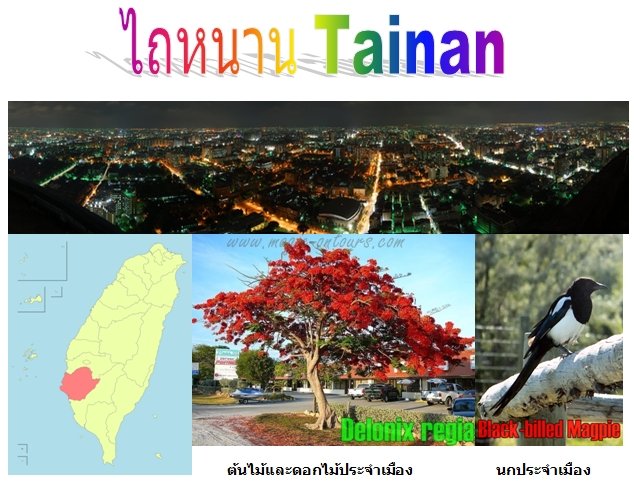
มหานครไถหนาน (จีนตัวเต็ม: 台南縣 Táinán Xiàn) เดิมคือ เทศมณฑลไถหนาน เป็นมหานครหนึ่งของสาธารณรัฐจีนเป็น มหานครทางใต้ของไต้หวัน ไถหนานถูกดำเนินการปกครองเป็นมหานครของสาธารณรัฐของจีนอย่างเป็นทางการ
เมืองไถหนานตั้งอยู่ทางตอนใต้ของเกาะไต้หวัน โดยคำว่า ไถหนาน ( 臺南) ได้บ่งบอกอย่างชัดเจนแล้วว่าเป็นเมืองที่ตั้งอยู่ทางตอนใต้ของเกาะไต้หวัน เพราะคำว่า หนาน (南) แปลว่า ใต้ เมืองไถหนานถือว่าเป็นเมืองที่มีความเจริญในระดับหนึ่ง มีสนามบินภายในประเทศตั้งอยู่ อีกทั้งยังมีสถานีรถไฟความเร็วสูง(Taiwan High Speed Rail 台灣高鐵) ที่สามารถเดินทางไปไทเปได้ภายใน 1 ชั่วโมงเศษ และในอนาคตเมืองไถหนานมีนโยบายที่จะสร้างรถไฟฟ้าภายในเมือง ซึ่งถือเป็นนโยบายในการพัฒนาเมืองที่มีคุณภาพ
สำหรับเมืองไถหนาน มีสถานศึกษาหลายแห่งที่ถือว่ามีชื่อเสียงและได้รับการยอมรับของไต้หวัน เช่น มหาวิทยาลัยแห่งชาติเฉิงกง 成功大學 National Cheng Kung University เรียกเป็นภาษาไทยว่ามหาวิทยาลัยแห่งความสำเร็จแห่งชาติ นับเป็นมหาวิทยาลัยที่มีชื่อเสียงติดอันดับ 5 ในไต้หวัน และอยู่ในอันดับ 24 ของการจัดอันดับมหาวิทยาลัยที่มีคุณภาพในเอเชีย ใครที่สนใจจะศึกษาทางด้านวรรณกรรมภาษาจีน หรือวรรณกรรมต่างประเทศ มหาวิทยาลัยแห่งชาติเฉิงกงเปิดให้ศึกษาในระดับปริญญาเอก โดยมหาวิทยาลัยแห่งนี้มีนักศึกษาไทยเข้ามาศึกษาอยู่ไม่น้อยทีเดียว
อำเภอทั้งหมด 37 อำเภอ


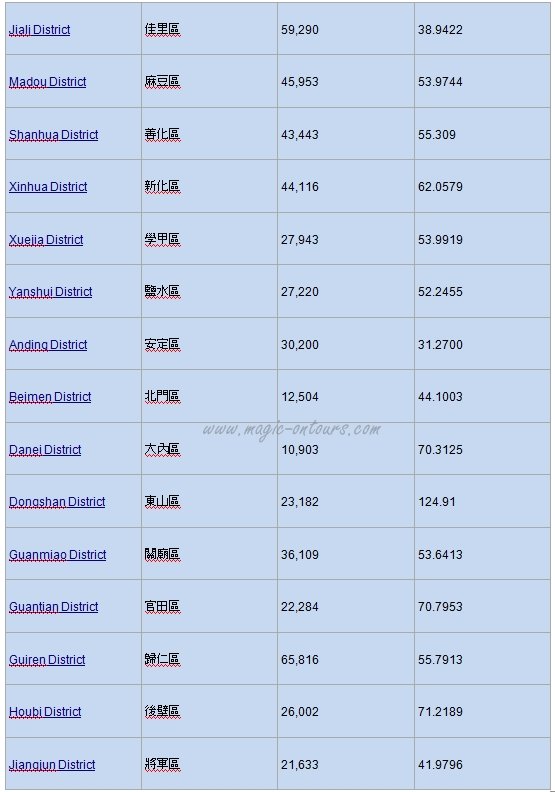
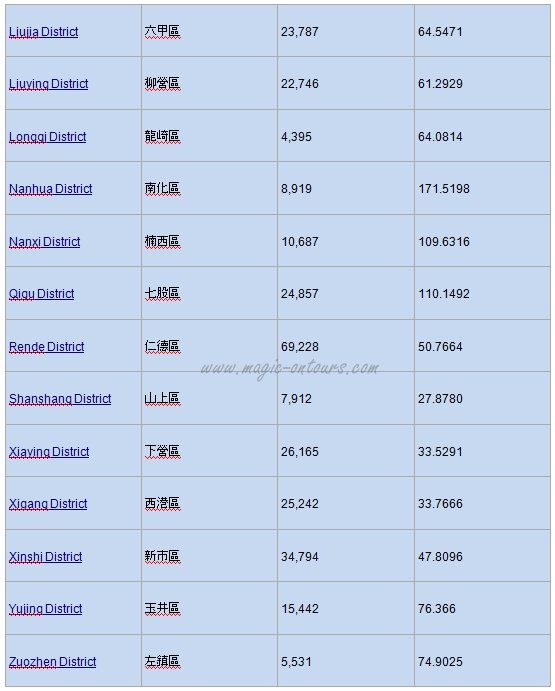
สภาพภูมิอากาศ
เกาะไต้หวันตั้งอยู่ระหว่างเขตร้อนและกึ่งเขตร้อน จึงมีลักษณะภุมิอากาศแบบเขตร้อนและกึ่งเขตร้อน เนื่องจากถูกล้อมรอบด้วยทะเลจึงได้รับอิทธิพลจากลมมรสุม ทำให้ที่นี่อากาศเย็นสบาย ไม่ร้อนหรือหนาวเกินไป อุณหภูมิโดยเฉลี่ย 22 องศาเซลเซียสต่อปี (ไม่รวมพื้นที่ๆ อยู่บนยอดเขาสูง) อาจจะมีหิมะในพื้นที่ๆ อยู่เหนือระดับน้ำทะเล 3,000 เมตรขึ้นไป มีฝนตกชุกและมีพายุพัดผ่านบ่อยครั้ง
เวลา
เวลาในประเทศไต้หวัน เร็วกว่าประเทศไทย 1 ชั่วโมง
ภาษา
ใช้ภาษา จีนกลาง (Mandarin) เป็นภาษาราชการ ฮกเกี้ยน (หมิ่นหนาน) เป็นภาษาท้องถิ่นที่ใช้ทั่วไปคู่กับจีนกลาง ข้าราชการระดับสูงทั่วไปสามารถใช้ภาษาอังกฤษได้
เงินตรา
ใช้สกุลเงิน เหรียญไต้หวัน (New Taiwan Dollar : NTD) 35.06 NTD = 1 USD หรือ 1 เหรียญไต้หวัน = 1.2168 บาท
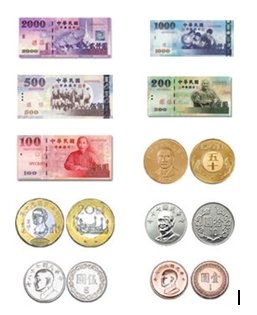
ระบบไฟฟ้า
ไต้หวันใช้กระแสไฟฟ้า แบบ 110 V. 60 Hz (ไม่เหมือนประเทศไทย) ปลั๊กเสียบเป็นแบบ ขาแบน 2 ขา ฉะนั้นท่านที่มีเครื่องใช้ไฟฟ้า เช่น กล้องวิดิโอ โทรศัพท์เคลื่อนที่ เครื่องเป่าผม ควรมีปลั๊กแบบใช้ได้ทั่วโลก (Universal Adaptor) ติดตัวไปด้วย เพื่อความสะดวกของท่านกรุณาเตรียม ฟิล์มถ่ายรูป, แบตเตอร์รี่ ไปให้เพียงพอจากประเทศไทย
ตัวอย่างปลั๊กไฟในไต้หวัน
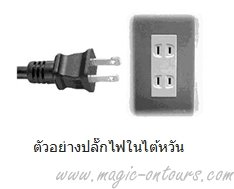
ฟิลม์และกล้องถ่ายรูป
ควรเตรียมไปให้เพียงพอโดยเฉพาะฟิล์มเพราะที่ต่างประเทศราคาจะสูงมากโดยเฉพาะ ตามสถานที่ท่องเที่ยว และควรเตรียมถ่านใส่กล้องถ่ายรูปไปด้วยเพราะอากาศเย็นถ่านจะเสื่อมสภาพเร็ว
การใช้โทรศัพท์
โทรศัพท์ทางใกลจากไต้หวัน : รหัสโทรทางไกล (002 หรือ 009) + รหัสประเทศ (รหัสประเทศไทย 66) + รหัส พื้นที่ (เลข 0 ข้างหน้าเอาออก) + เบอร์โทรศัพท์
โทรศัพท์ถึงไต้หวันจากต่างประเทศ: รหัสโทรทางไกล+ 886 + รหัส พื้นที่ (เลข 0 ข้างหน้าเอาออก) + เบอร์โทรศัพท์
การให้ทิป
การให้ทิปในต่างประเทศ ถือเป็นเรื่องสำคัญ และมารยาทของนักท่องเที่ยวควรให้ทิปสำหรับคนที่ให้บริการท่าน อาทิคนขับรถ / ไกด์ท้องถิ่น ที่คอยอำนวยความสะดวกให้แก่ท่านระหว่างการเดินทาง
ขนส่ง
1.THSR Tainan Station (高鐵台南站) คือ รถไฟความเร็วสูงของไต้หวัน ตั้งอยู่ในอำเภอGuiren ของเมืองไถหนาน นอกจากนี้ผู้โดยสารยังสามารถเชื่อมต่อไปยังรถไฟท้องถิ่นสายTRA Shalun ได้อีกด้วย
2.สถานีไถหนาน (台南车站) เป็นสถานีรถไฟอยู่ภายใต้การบริหารรถไฟ (TRA) แนวตะวันตก ของไต้หวัน ตั้งอยู่ใน East District ของเมืองไถหนาน สถานีไถหนานถือเป็นสถานีหลักของเมืองและยังเป็นหนึ่งในสถานีหลักเส้นตะวันตกของไต้หวันด้วย
3.สนามบินไถหนาน ( จีน : 台南机场 ; อย่างเป็นทางการ “台南航空站“) ( IATA : TNN , ICAO : RCNN ) เป็นสนามบินพาณิชย์ที่ตั้งอยู่ในSouth District ของเมืองไถหนาน โดยสนามบินไถหนานยังถูกใช้ร่วมกับกองทัพอากาศ ไถหนาน AFB ของสาธารณรัฐประชาชนจีน และมันยังเป็นอันดับที่สามของสนามบินที่มีผู้มาใช้บริการมากที่สุด รองจาก สนามบินซงซาน และ สนามบินเกาสง
เทศกาล
1. Ghost Festival in Taiwan’s Tainan City
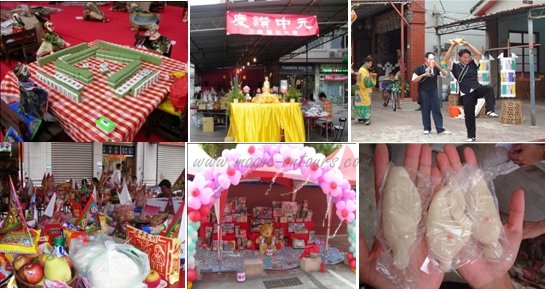
Ghosts play a special role in the Chinese world. While there are many complicated feelings about them, over time, they have become part of many rituals. Among festivals that include them, the most important may be the one called ‘The Ghost Festival.’
In Tainan, a city in southern Taiwan where many Chinese from the People’s Republic of China went to live, the Ghost Festival is celebrated with considerable traditional atmosphere. This article introduces this festival and its offerings in Taiwan and discusses its symbolism in the city of Tainan when people worship ghosts.
The Ghost Festival occurs during July on a date found on China’s traditional Lunar calendar. Actually, the Chinese believe that this is a month belonging to ghosts; so they call it the ‘Ghost Month.’ During this lunar month, they believe that guilty ghosts are released from their hell and enter man’s world to receive offerings including food and articles for daily use.
A ritual occasion held for ghosts is called Pu-du. When it occurs can differ depending on time, place, objects, ritual holders, and ritual performers. These ghost rituals are usually performed by Buddhist and Taoist priests, but common people can and do provide ritual offerings; they are also called Pu-du.
In Taiwan, Pu-du is not only held during Ghost Month; it is usually held on three occasions. One is during Ghost Month when temples, companies, and households holdPu-du. Another is when Giao, advanced rituals in Taoism, are practiced. This happens on the last day of Giao when Pu-du is held. The above two times are reserved to worship ghosts. They are done so that the ghosts will not disturb man’s world and will not spoil order in human life. The third time Pu-du is held is on the day before a funeral. Its purpose on that day is to prevent other ghosts from bullying the recently departed individual.
There are several common offerings for ghosts on these occasions. Some, taken by the authors, are pictured with this article that explores the meanings of those practiced. They are seen as a way to understand them and their purposes. They are divided below into their main cultural components.
Food Offerings: These are given by people or priests. They are known as the ‘Three Sacrifice,’ the ‘Five Sacrifice,’ and a ‘Pig’ and a ‘Goat.’ These offerings are examples of people’s largess during Ghost Festivals.
The Three Sacrifice offerings consist of a boiled chicken, a boiled duck, and some boiled meat. The Five Sacrifice ones include boiled foods, too, and a chicken, duck, fish, some meat, and a big squid or some shrimp. In addition to these boiled foods, a whole raw pig and a whole raw goat are presented.
DAILY USE ARTICLES are for ghosts to cleanse themselves and make themselves decent. These are common items such as combs, soap, toothbrushes, toothpaste, cups, and towels. In addition, there are things for females including perfume, cosmetics, needles, and other sewing items.
FEASTS: are made up of ten to twelve dishes, a pan of rice, a pot of soup, and wines or other beverages. Of course, cups, bowls, and chopsticks are given so that the ghosts can consume the foods.
ENTERTAINMENT: is provided for the ghosts, as well. It can include mahjong tiles and boards, playing cards, Chinese chess, and Chinese checker sets. Sometimes, toys for children are among the offerings.
ITEMS OF APRECIATION are also offered, usually placed on tables. They are offerings of various shapes, and they can be quite decorative. They might be made of dough, or they might be hand-carved fruits. Usually, there are many of them displayed on many tables. They can include longan fruit which is tropical, and when growing it produces many individual fruits. Its productivity symbolizes the availability of lots of food offerings for ghosts. Moreover, as it is a round in shape, the Chinese believe it corresponds to perfection. Longan fruit is used frequently for worship. Buddha’s hand, made of dough and seen on this page, is an offering with a different religious meaning. In Buddhist and Taoist ceremonies it stands for the hand of Buddha saving guilty ghosts. Priests and monks throw Buddha’s hands to people during Pu-du and many people are keen to grab one. It is said that this hand can protect people after they eat it. Betel nuts and cigarettes are essential while worshiping ghosts and the dead in hell. These things represent those in lower social ranks, and they reflect the real world to the ghost or other world. Betel nuts, cigarettes, and wine are used as offerings to please the ghosts. They show that the ghosts will not be a disturbance in man’s world; they are presented while worshiping ghosts.
RESPECT AND FEAR OF GHOSTS does exist. Offerings to them are a ritual exchange expressing their complex feelings toward ghosts. They are afraid of two kinds of ghosts, those from people who die in accidents and those who have no descendants. Both of these kinds of ghosts are said to be harsh and aggressive. They are probably ghosts who bring bad luck or disaster to humans. Therefore, to worship them is to tame them and make them come under the authority of the Gods of Taoism or Buddhism. Worshiping them can prevent bad luck or disasters that they might cause.
IMAGINATION AND SYMBOLIC MEANINGS are reasons for ghost offerings. People try to imagine what the other world is. They see their daily life as a reflection of that world. Some ghost offerings are adopted because their shapes provide special hints and add meanings. These can be through words or by their material shapes as used in their ceremonies. They can show several aspects of interactions and relationships.
PU-DU is both a religious ritual and a social function. It offers a stage for temples to show off the number of offerings given. It also offers a complex set of other cultural meanings associated with the Chinese culture and with its local people in Tainan.
OVERALL, this is a but brief introduction to Tainan’s Ghost Festival. Those interested in learning more can check out the following: Stephen Teisern’s The Ghost Festival in Medieval China published in Princeton NJ by Princeton University Press in 1988; and Ghosts Festivals, Culture, and Symbols in Tainan City. This was in the 2007 Journal of Chinese Dietary CultureVolume 3(1) on pages 81 through 136. The latter is in Chinese.
Accompanying this article are food pictures and other things and some other views taken during a recent Ghost Festival in Tainan, Taiwan.
2. Yanshui Beehive Firecrackers Festival in Tainan
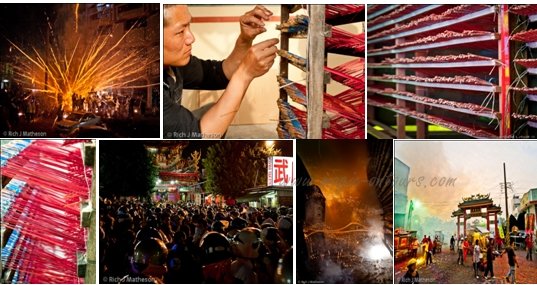
2013 the Tainan Yanshui Firecrackers Ceremony (Yanshui Beehive Firecrackers Festival in Tainan) will be held on 2013/02/23-02/24 which is the 14th and 15th of first lunar month. The event will start at six in the evening with a marching parade, and the destination of the parade is Yanshui Wu Temple’s plaza. The box-like wooden structure castles of firecrackers built by the residents in Yanshui will be set around the plaza and alleys. One of the tranditions of the ceremony is that instead of setting the firecrackers skyward, it will be aiming at the sedan chair of Guanyu and crowds. Thousands of tourists from local and abroad come and participate this unique Taiwanese extravaganza and to test their limit. To experience the excitement of firecracker bath, participants should not forget to cover the full body with helmet, scarf, gloves and thick outfit to avoid injury.
Other than the major event mentioned above, visitors may also enjoy many delicious local snacks, including Yanshui Noodles, egg cakes, red bean cakes and many others. Also, being the former capital city of Taiwan, Tainan has extensive cultural and historical assets for you to discover during your visit to Yanshui. Visitors are invited to come to the city early to discover the city splendors before the Yanshui Firecrackers Ceremony (Yanshui Beehive Firecrackers Festival in Tainan).
The Yanshui Firecrackers Ceremony in Tainan city is getting ready to attract a more agitated crowd on Lantern Festival night by setting off over hundreds of thousands of firecrackers. Book your Tainan hotels today at Sinotour.com and get ready to discover the unparalleled beauties of these mesmerizing Taiwan towns!
3. Sand & Salt Sculpture Festival in Tainan
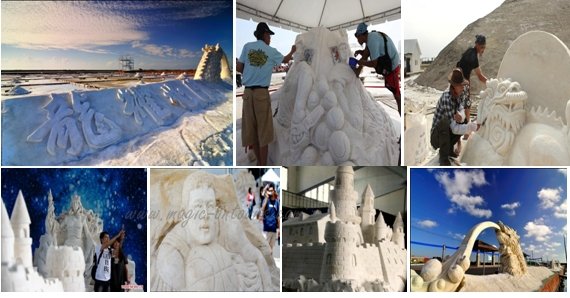
Sand, salt sculpture festival to be held in Tainan in June
2012/05/10 20:25:05
Taipei, May 10 (CNA) A festival featuring both sand and salt sculptures will take place in Tainan City next month to showcase the region’s rich natural resources, the Tourism Bureau said Thursday.
The festival, scheduled for June 2-July 15, marks the bureau’s first attempt to bring together “the two gifts from the ocean” to promote local tourism, said bureau official Cheng Jung-feng.
“Using such small particles to create Tainan as a unique travel destination could bring us huge returns,” Cheng said, explaining that the area in southwestern Taiwan is known for both its coastal scenery and traditional salt-production industry.
The festival will also feature the largest salt sculpture ever made in Taiwan.
The artwork, approximately 400 square-meters in size, will be a collaboration between sculptors from Taiwan, Canada, Japan, China and the Netherlands.
A total of 15 sand sculptures and 22 salt sculptures of various themes will be on display, including cartoon characters, animals from the Chinese zodiac and even sports figures like NBA basketball playerJeremy Lin and Major League Baseball pitcher Wei-Yin Chen.
Wang Song-guan, project leader of the salt sculpture section, encouraged the public to come and see both kinds of sculptures because the art forms were very different from each other.
“I suggest that people take a close look at the details of the sculptures and consider how light and shadow effe
สถานที่ท่องเที่ยว
1. Eternal Golden Fortress (億載金城; Yì Zài Jīnchéng)

ไม่นานก่อนไต้หวันจะเลิกเป็นเมืองขึ้นของประเทศญี่ปุ่น ป้อมปราการแห่งนี้สร้างขึ้นเพื่อปกกันภัยคุกครามและการโจมตีจากญี่ปุ่น สร้างขึ้นในปี 1874 เสร็จสมบูรณ์ในปี 1876 ได้จ้างสถาปนิกชาวฝรั่งเศส ชื่อ Bordeaux เพื่อจะสร้างป้อมปราการให้ทันสมัย ป้องกันการโจมตีทางทะเลจากเรือของญี่ปุ่น มีปืนใหญ่หนึ่งกระบอกหันหน้าออกทางทะเล และนี่คือป้อมปราการที่ทันสมัยในยุคแรกๆของไต้หวัน ประกอบด้วยกำแพงอิฐขนาดใหญ่ที่มีผนังล้อมรอบ มีคูน้ำล้อมรอบป้อมปราการอีกชั้น ประตูทางเข้าทางตะวันออกเป็นอุโมงค์ขนาดใหญ่ที่ก่อด้วยอิฐสีแดง ที่ปากทางอุโมงค์มีสะพานไม้ใช้ข้ามผ่านคูน้ำและได้ติดตั้งปืนใหญ่อาร์มสตอง ที่มีอนุภาพร้ายแรงของประเทศอังกฤษขึ้นภายหลัง ป้อมนี้จึงใช้ทหารเพียงน้อยนิดในการประจำการ ที่แห่งนี้อาจไม่ค่อยน่าสนใจสำหรับนักท่องเที่ยว แต่มันก็คุ้มค่าในการเข้าชมถ้าคุณมีเวลา บริเวณรอบๆกำแพงสามารถเดินเล่นพักผ่อนได้ เหมาะสำหรับการเดินทางมาปิกนิกกับครอบครัว
Not long before Taiwan was handed over to Japan, this fort was built to increase defense against the threat of invasion from those very same Japanese. The Qing leadership began building the fortress in 1874 and completed it in 1876. They hired a French architect named Bordeaux to construct a modern fort that could defend the city from a sea attack. A spot was chosen along the coast not too far from the defunct Fort Zeelandia. Famously, bricks were taken from the remains of Fort Zeelandia for use in fort’s construction.
one of the cannons facing the sea
This was the first modern-era fort built in Taiwan. Its three hectors consist of a square central field with large walls surrounding it. There are bastions at the four corners pushing out from the square design so that from above the fort looks like a square with a large “X” crossing through it. A moat surrounds the fort tracing its shape. The entrance is a large brick tunnel on the east side of the fort. At the tunnel entrance there was a wooden drawbridge that spanned the moat. The central field was a practice ground and contained a pond at one time. Under the fort was a kitchen, granary and ammunition depot. The fortress was equipped with British “Armstrong” cannons, making it the first fort in Taiwan with such modern artillery. Cannons were posted on each bastion and along the sea-facing wall. It had 5 eighty-ton, 4 forty-ton and 4 twenty-pound guns.
the south-east bastion
The fort saw just two minor military incidents in its time of use. The cannons were first fired to ward off a fleet of, ironically, the designer’s countrymen during the Sino-French War of 1884. The second time was a similar warning action against the Japanese in 1895, just before Taiwan was ceded to them.
the moat
When Japan took over Taiwan, the fort came into disuse. Its abandonment was punctuated during their war with Russia when the Japanese sold off some of the cannons to help fund the war in the north. Without the cannons the fort had no value for defensive purposes, and so it was left to nature.
The fort didn’t blossom as a tourist attraction and piece of cultural heritage until its centennial. In 1976, the government repaired the fort and called for a year of tourism. For the next several years, the area was developed for tourism and in 1983 the fort was named a national first-class historic site.
the ceremonial firing of the cannon
While the Eternal Golden Castle is probably the least interesting of the seven first-class historic sites in Tainan, it is still worth a visit if you have the time. The trees growing around the walls make for a very attractive stroll around the grounds. In fact, the fort feels very much like a park and you may even be tempted to bring a lunch and plop yourself down on a picnic blanket in the middle of the training ground. If you’re up for some activity, there are paddle boats for rent if you want to go around the moat. In the evenings the grounds are often used for musical events and performances. During the day, there are some people who dress up in period costumes and fire off the one working artillery gun that’s in the north-west corner.
2. Anping Tree House (安平樹屋)
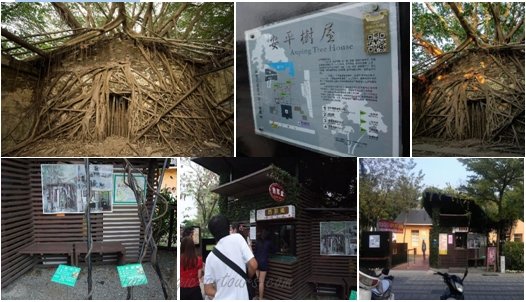
เคยเป็นโกดังสินค้าเก่าของบริษัทการค้าขายต่างประเทศ หลังจากที่บริษัทสินค้าละเลยการดูแลสภาพจึงทรุดโทรมมีต้นไม้ต้นไทรเถาวัลย์ เติบโตในบริเวณรอบๆหลายปีต่อมาเถาวัลย์จึงปกคลุมอาคารทั้งหมด รากต้นไทรได้เลื้อยเข้ามาข้างในผ่านทางหน้าต่างและเร็วๆนี้พึ่งได้รับการบูรณะขึ้นมาใหม่ เพื่อมาเป็นสถานที่ท่องเที่ยวแทน ผ่านในมีบันไดไม้และบันไดเหล็กที่ทำขึ้นอย่างมีรสนิยม เพื่อจะได้ไม่ทำลายบรรยากาศ จึงเป็นสถานที่ที่เหมาะแก่การมาถ่ายภาพ ตัวอาคารค่อนข้างน่าสนใจ ขั้นล่างมีการจัดนิทรรศการซึ่งมีรายละเอียดและประวัติของพื้นที่แห่งนี้ ทั้งก่อนและหลังการบูรณะขึ้นมาใหม่
The Anping Tree House is actually an old warehouse of a foreign trading company, Tait and Co. After years of neglect, the warehouse fell into disrepair and banyan trees began to grow in and around it.
Many years later, the trees engulfed the whole building, with roots spiraling and snaking in and out of windows, doors and roofs. When the Anping area was renovated recently, this warehouse was transformed into a tourist attraction and opened up to the public.
There are wooden and metal staircases inside to help you get around, but it has been done tastefully so as not to ruin the atmosphere. It’s a great place for looking around and taking pictures. Make sure you also visit the Old Tait & Co. Merchant House next door. The building itself is rather attractive, and on the first floor there is an exhibition which details the history of the area with some great pictures from previous times.
Anping Tree House was originally the warehouse of Tait & Co. During the Japanese Occupation it was the office and warehouse of the Japan Salt Company. After World War II, the salt industry in Anping declined, and this area was abandoned. The aerial roots and branches of banyan trees wrapped around the building, combined with the soil, red brick and partial concrete wall creates an unusual sight. (Taken from the ticket) Location: 108 Fort St., Anping District (entrance through the back door of Old Tait & Co. Merchant House). NT$50.
3. Chihkan Towers (赤崁樓 Chìkàn Lóu)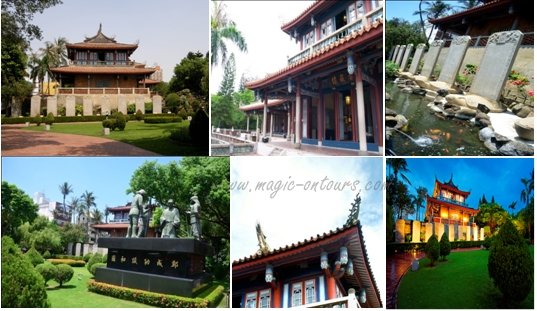
เป็นสถานที่สำคัญของไถหนาน เป็นโบราณสถานที่มีชื่อเสียงสร้างโดยชาวฮอลแลนด์ ในปี 1653 ส่วนคนตั้งชื่อคือชาวจีน ในพื้นที่มีตัวอาคารที่มียุคทางประวัติศาสตร์ที่แตกต่างกัน ยังมีแง่มุมให้คิดในด้านความสง่างามของสถาปัตยกรรมของจีนในอดีตและปัจจุบัน
Chihkan Tower is the landmark of Tainan and its most famous historic site. In 1653 the Dutch built “Fort Provedentia” in the area, and the Chinese named it “Tower of Savages” or “Tower of Red-haired Barbarians.” Chihkan Tower is its official name today. Even though Chihkan Tower has survived different historical periods, it retains its rich and graceful architectural aspects. Crammed with various kinds of steles, stone horses, weight lifting rocks, stone weights, and nine stone tortoises carrying royal stele carved in both Chinese and Manchurian, the courtyard looks like an outdoor museum. Chihkan Tower is particularly attractive at night. (Taken from the ticket) Location: 212 Sec. 2, Min-Tsu Rd., Central District. Hours: 8:30AM-9PM. NT$50.
4. National Museum of Taiwanese Literature
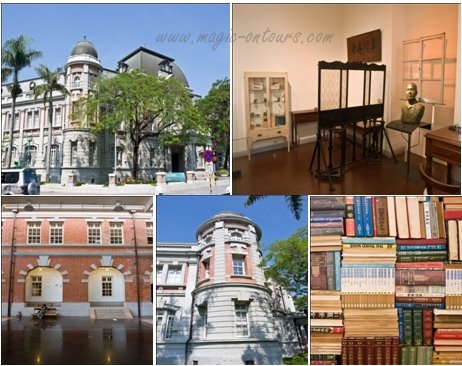
ตั้งอยู่ในอาคารที่ได้รับการบูรณะ ในยุคล่าอาณานิคมของญี่ปุ่นเป็นพิพิธภัณฑ์เก่าแก่แห่งชาติ สร้างขึ้นในปี 1916 เปิดในปี 2003 อยู่ในตอนใต้ของไถหนาน พิพิธภัณฑ์แห่งนี้มีหัวข้อในการเข้าชมเกี่ยวกับร่องรอยทางประวัติศาสตร์ และการพัฒนาวรรณกรรมของไต้หวัน ภายในได้รับการปรับปรุงสถาปัตยกรรมให้น่าสนใจยิ่งขึ้น โดยเฉพาะอย่างยิ่งการก่อสร้างด้วยอิฐอย่างมีเอกลักษณ์มีจอมอนิเตอร์ ภาษาอังกฤษอธิบาย มีร้านอาหารและร้านกาแฟอยู่ภายในเหมาะสำหรับการพักผ่อน
Located in a restored colonial-era Japanese building, even with the limited English on display this museum is fascinating. The coffee shop is good too. The National Museum of Taiwanese Literature was opened in 2003 in the southern city of Tainan. The museum is dedicated to researching, preserving, cataloging and exhibiting literary artifacts. The museum thematically traces the history of Taiwan’s literary development. The introduction celebrates Taiwan’s spirit of self-determination, and highlights her struggle as she treads her literary journey.
The museum is housed in a national historic building, the former Tainan City Hall. Built by the Japanese in 1916, the architecture is in the Mansard style, made popular by the French architect Francois Mansart (1598-1666), and was a commonly used style in European and North American public buildings in the 19th century. The building was badly damaged during the second world war, and was subsequently used as for the Supply Department for the ROC Air Force, before once again becoming the City Hall until 1997.
The renovated architecture inside is particularly interesting, with lots of internal archways and columns, as well as some beautiful brickwork.
Inside there are eight exhibition rooms, showcasing the history and development of Taiwanese literary through a range of languages, including Taiwanese, Japanese, Mandarin and Classical Chinese. Subdued lighting sets the mood producing some interesting shadow effects around the displays.
One of the exhibition rooms is dedicated to Lai He, widely considered the father of Taiwanese new literature. Born in Changhua in 1894, he was a novelist, poet and doctor. Lai He was the leading representative poet throughout the Japanese colonization. As a doctor, he opened a clinic where he saw patients, as well as a reading room where he wrote and kept a large collection of books, newspapers and magazines for friends, students and patients to read. He was also a prominent social activist, discussing current events, Taiwan’s future direction and served as a mentor for young writers. He died in 1943
There’s also a children’s section where the young can learn about various writers, read some simple books or try their hand at calligraphy.
I’ll leave you with a couple more images to close.
The museum is located at no 1, Zhongzheng Rd, Tainan city.
Stay tuned later in the week when I’ll announce the winning image from the Taipei Photowalk.
5.Taiwan Confucian Temple

The Taiwan Confucius Temple, also called the Scholarly Temple was built in 1665 when Cheng Ching, son of Koxinga so as to offer lectures and cultivate intellectuals. It was the first learning institute of children when Taiwan was ruled by Qing Dynasty .As the result, it is also called the First Academy of Taiwan. The Confucian temple serves as a popular tourist attraction and also preserves ancient Confucian ceremonies, which are conducted on a regular basis. The temple also includes storerooms for the ritual implements and musical instruments that are used in these ceremonies.
6. Guanziling
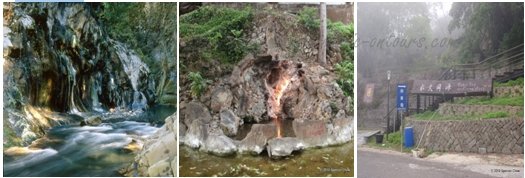
Due to the special properties of the rocks in Chengtoushan, Guanziling is renowned for its mud hot springs. The history of this hot spring goes back over a century, when Taiwan was under Japanese rule and the occupier’s army generals enjoyed natural Guanziling baths.
Because of the stratified mud located at its source and the fact that Guanziling Hot Springs contains sodium and other types of minerals, the water from the hot springs is a murky color, thus resulting in it also being known as “The Murky Hot Springs.” This kind of hot spring is only found in Japan, Italy, and Taiwan.
The alkaline qualities of the water are said to help relieve exhaustion and cure skin allergies, chronic gastronomical diseases, and tendonitis. The waters of the Guanziling Hot Springs will not only kill bacteria, but also make skin feel smooth.
Guanziling Hot Spring is located high on the cliffs of Chengtoushan. Since in Hoklo, the pronunciation of “Gao” (high) is similar to the Mandarin pronunciation of “Guan,” the hot springs is named Guanziling. Besides being one of the oldest hot spring sites in Taiwan, it has also been listed by the Tainan County government as one of the eight main tourist attractions in Tainan County. The county government has also set up a hot springs museum in the nearby Guanziling Park, providing tourists with extensive information about the natural attraction.
The lotus farm in nearby Baihe Town is one of the best places in Taiwan to view lotus blossoms. In addition to viewing the flowers, visitors also have the opportunity to taste cuisines that feature the lotus as their main ingredient. Every part of the lotus is edible, from the root, leaves, flowers, seedpod, and seeds, to the white membrane, and seed husks. Local restaurants prepare all kinds of lotus dishes, including lotus seed sticky rice tamales, lotus chicken, lotus seed congee, lotus root tea, and lotus leaf pork ribs.
Guanziling covers a vast area in Tainan County. “Shui Huo Tung Yuan” (Water and Fire from the Same Origin), also called the “Fire and Water Hole,” is recognized as one of the seven most amazing natural phenomena in the country. Normally, water and fire are not able to coexist, but due to the unique geological structure of the area, natural gas seeps through cracks in the cliff and mixes with water seeping out of other cracks, so creating the seemingly impossible wonder of “Shui Huo Tung Yuan.”
Guanziling also includes historical sites, such as Lingding Park, Hongye Park, and Haohanpo Hiking Trails. These sites have all been integrated with Guanziling, forming a hot-springs-themed area, so Guanziling remains a wonderful choice for someone who enjoys hiking through nature’s splendor or simply relaxing.
7. Garden Night Market花園夜市 huāyuán yèshì
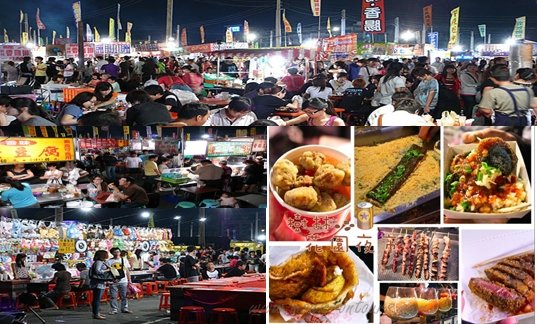
There are over two dozen night markets of various sizes in and around the city. Regardless of size, night markets all possess an abundance of stalls selling clothing, shoes, jewelry, toys, food and drink. Some even have live entertainment.
Most night markets are only held on certain days of the week. Check before going.
The biggest and most famous night market, the Garden Night Market (花園夜市 huāyuán yèshì) is open on Thursday, Saturday, Sunday. There are tons of food stalls and game booths, but be warned that this market can get very busy (i.e. mosh pit busy) on some days.
TAINAN NIGHT MARKETS
Posted by tainancity on September 29, 2010 · 9 Comments
Hot, noisy, and intensely crowded, night markets reflect the heart and soul of Taiwanese culture.
Tainan Night Markets (Táinán Yèshì 台南夜市)
Anyone will tell you that the essential Taiwanese cultural experience is a visit to any of the island’s numerous night markets. Pubs and night clubs are mere subcultures compared to the mass-assembly of nightlife in Taiwan’s night markets, and many Taiwanese never tire of braving the crowds. Tainan is no exception when it comes to night market culture. In fact, much of the street market food you find all around the island originated at Tainan’s night markets. While you no longer have to travel to Tainan to eat danzai noodles or coffin bread, many visitors still make Tainan’s night markets a priority in their visit.
A variety of food stalls line the aisles.
Night markets are essential to Chinese culture and have been around for more than a thousand years. They have a long and storied tradition, both on the mainland and on this side of the Taiwan Strait. In fact, much of the political and social history can be found in the bends and curves of night market culture. Under the Japanese, night markets were highly regulated. During the 1950′s, they boomed in Taipei due to the increase of migrant workers from the south. During the 70′s, merchandise like handicrafts and herbal remedies were replaced by off-sales of the Made in Taiwan boom. These days, those same light industry products are sold, but they usually come from China. Traditions involving night markets have changed with the seasons, but they have always been meeting grounds in which people have gathered to socialize, shop, and eat.
Win a stuffed animal in a game of chance.
For newcomers, night markets are a lot to take in. On the one hand, they are crowded, hot, noisy, and unsanitary places. On the other hand, they are a vibrant sense-explosion, offering a multitude of affordable eating, shopping, and entertainment experiences all in one place.
Most markets are divided into separate sections for food, merchandise, and games. These sections all consist of small vendor stalls lined up in rows, competing with each other for the attention of the hoards of people trying to pack through the lanes. The food is usually of the xiaochi (literally: small eat) variety. Many food stalls offer Taiwanese staples, but many others are vying for business with foreign delights or anything new. You can find fruit, iced drinks, candy, pastries, wraps, food on stick, or even steak, just to name a few things on offer. Purses, costume jewelry, and T-shirts with bad English printed on them are the basics at the shop stalls, but like the food vendors, many sellers branch out to cover all manner of things. Most food and goods are cheaper here than in restaurants or stores, but don’t expect high quality. As far as entertainment goes, it’s usually off to the side or in the back of most night markets. There, you can find old-fashioned fairground games for kids or the young at heart. Try your hand and catching gold fish, dart-throwing, Mahjong Bingo, or any number of simple chance games.
Most markets are geared towards students, but families and people of all ages attend them. In fact, they are often the one place you can find people from all economic classes and walks of life.
Crowded food stalls at Hua Yuan Night Market
One thing to remember about Tainan’s night markets versus those of Taipei is that they are not open every night of the week. Each one has it’s own nights, so check the schedule before heading out. Luckily, there is always one night market or another running. The largest night markets are the Hua Yuan (flower garden) Night Market in the northwest of the city, and the Da Dong (big east) Night Market in the southeast. These two run three nights a week on alternating nights, so one of these is open every day except Wednesday. The Qingren (Lovers) Night Market is set on the same location as the Hua Yuan, but it is smaller, and runs on alternative nights. The other night markets are smaller, and I can’t say that I’ve been to any of them, but below is a schedule and address for each of them. Generally, they are all open from 6pm to 11:30 pm.
Hua Yuan Night Market (Huāyuán Yèshì 花園夜市)
Thursdays, Saturdays and Sundays; Haian Road, Section 3, between Lixian Rd. and Hewei Rd., North District. This is the largest night market in Tainan, and the largest fully-outdoor night market in Taiwan. Ample parking is provided here.
Da Dong Night Market (Dà Dōng Yèshì 大東夜市)
Mondays, Tuesdays, and Fridays; Linsen Road, Section 1, near Chongde Rd., East District. This is the second largest night market in the city. It is very popular on Friday nights, especially with NCKU students.
Qingren (Lovers) Night Market (Qíngrén Yèshì 情人夜市) – (EDIT – This one might not operate anymore.)
Mondays, Wednesdays, and Fridays; Haian Road, Section 3, between Lixian Rd. and Hewei Rd., North District. A smaller version of Hua Yuan night market, running on alternative nights.
Wusheng Night Market (Wǔshèng Yèshì 武聖夜市)
Wednesdays and Saturdays; Wusheng Road, a few blocks west of Wen Xian Rd., North District. Not easy to find, but it’s one of the longest running night market in the city.
Yonghua Night Market (Yǒnghuā Yèshì 永華夜市)
Thursdays and Sundays; Yonghua Road, Section 2, at Yonghua 4th St., Anping District. Probably the newest night market. It’s a few blocks past the Anping Carrefour.
Kaiyuan Night Market (Kāiyuán Yèshì 開元夜市)
Wednesdays and Saturdays; Kaiyaun Road at Linsen Road, Section 3, North District. On the northeast side, not far from NCKU.
Xiao Bei Night Market (Xiǎo Běi Yèshì 小北夜市)
Tuesdays and Fridays; Ximen Road, Section 4, at the intersection of He Wei Rd., North District. One of the oldest night markets in the city.
9. National Museum of Taiwan History
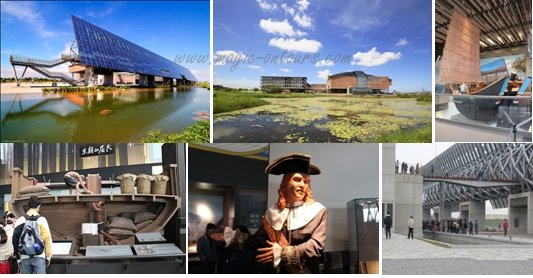
The National Museum of Taiwan History will hold its grand opening in Tainan City Oct. 29, following 12 years of preparation, museum authorities announced.
“We will present the history of the Taiwanese people, in a museum designed for them,” Director Lu Li-cheng said at a news conference in Taipei Oct. 24.
To this purpose, more than 60,000 items have been collected from home and abroad, including materials and documents pertaining to local cultural life, interactions among ethnic groups and folk heritage, Lu said.
Of particular note is the collection of historic maps, charts and documents that the museum has obtained from foreign collectors. “They will provide us with different viewpoints from which to look at Taiwan’s history.”
The museum presents “both history and Taiwan in one museum,” Lu said, distinguishing it from the National Taiwan Museum and the National Museum of History, both in Taipei. The NTM focuses on natural history while the NMH highlight Chinese culture in Taiwan, he explained.
The Tainan museum is located in the Annan District—historically an estuary and foreign trading hub until the river silted up in the 18th century.
According to the museum, the 20-hectare facility, to echo this past and its legacy, includes a nature reserve of 10 hectares and buildings combining Han Chinese red bricks with aboriginal architecture. It also sports a wall of photovoltaic panels that reflects the sky and provides electricity for the museum.
Beginning opening day, a series of concerts, folk art performances and market fairs will take place around the museum. Entry will be free for the first year of operation, the museum said. (THN)
อาหาร
1. Oyster omelette
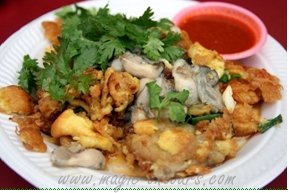
2. Oysters and thin noodles
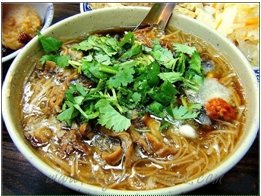
3. Dan Zai Noodle

4. Elite Cake (狀元糕 zhuàngyuan gāo)

5. Coffin toast (棺財板 guāncaibǎn)

6. Bowl rice cake (碗稞 wǎnkē)
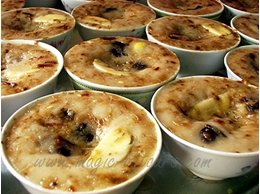
7. Eel noodles
























